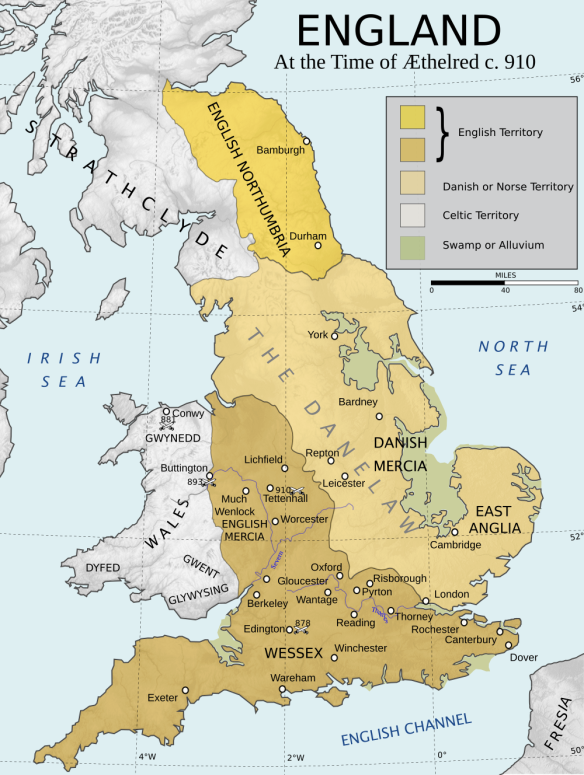King of England 978-1016,
Æthelred was the son of the English king, Edgar (d. 975), and his wife, Ælfthryth (c. 944-999/1001), and was perhaps nine years old when his father died. His elder half-brother, Edward the Martyr (d. 978), became king, but was murdered by a faction linked to Æthelred’s mother. Æthelred was formally consecrated king on 4 May 979. He was married twice, firstly to Ælfgifu, by whom he had six sons (Athelstan, Ecgberht, Edmund Ironside, Eadred, Eadwig, and Edgar), and secondly, in 1002, to Emma of Normandy, by whom he had two sons (Edward the Confessor and Alfred the atheling) and one daughter (Godgifu).
His nickname is derived from Old English unræd, which means “poor counsel,” and is a pun on the literal translation of his first name (“noble counsel”). However, although the Anglo-Saxon Chronicle is critical of Æthelred’s policy toward the Vikings attacking his kingdom, this nickname is not contemporary and is not evidenced in written sources until the 13th century. Indeed, the Anglo-Saxon Chronicle’s account of Æthelred’s reign was written after his death and the accession of Cnut I the Great and therefore seems to reflect the benefit of hindsight in its assessment of Æthelred’s rule. However, Æthelred certainly seems to have been led astray by his counselors in the period 984-993, seizing church lands and granting them to nobles, before repenting in a charter; and after 1006, the growing influence of Eadric Streona, a treacherous ealdorman from Mercia, also seems to have caused problems. Nevertheless, there were some internal accomplishments, such as the issuing of the Wantage Code, which extended royal control in the Danelaw.
Æthelred’s accession to the English throne almost exactly coincided with the resumption of Viking raids in England in 980. The character of these expeditions was quite different from the earlier assaults, with well-organized armies, operating under Scandinavian kings and princes, demanding large payments of silver. In 991, the future king of Norway, Olaf Tryggvason, arrived with 93 ships at Folkestone in Kent and succeeded in extracting a Danegeld of £10,000 following the English defeat at Maldon. Olaf subsequently joined forces with King Svein Forkbeard of Denmark and together they ravaged southeast England and attacked London in 994, receiving yet another large tribute from the English (£16,000). In 1002, an even larger sum of money was paid out (£24,000), and in response to a supposed plot against his life, King Æthelred ordered that all the Danes in England should be massacred on St. Brice’s Day in 1002. However, this presumably antagonized his Scandinavian subjects living in the Danelaw and failed to keep the Viking threat at bay: raids continued and Danegelds were paid again in 1007 (£36,000), 1012 (£48,000), and 1014 (£21,000).
In 1009 a large army under the leadership of Thorkell the Tall arrived in England and campaigned extensively in southern and southeastern England for the next three years. Before it dispersed in 1012, virtually the entire area was under Scandinavian control according to the Anglo-Saxon Chronicle. However, Thorkell then decided to enter the service of Æthelred, and help him to combat a new Scandinavian army threatening England. In 1013, Svein Forkbeard landed at Sandwich before moving north. He quickly received the submission of Northumbria, Lindsey (North Lincolnshire), and the Five Boroughs at Gainsborough and then headed back south, taking hostages at Oxford and Winchester, and finally receiving the submission of London at Bath. Æthelred, his wife, Emma, and their two sons, Edward and Alfred, fled to Normandy and the protection of Emma’s family in 1013. However, Svein’s death on 3 February 1014 heralded a period of considerable political confusion: while the Danish fleet chose his son, Cnut, as king, the Anglo-Saxon councilors advised that Æthelred should be recalled from exile in Normandy, and he arrived back in his kingdom in 1014. Æthelred’s army proceeded to ravage Lindsey, and the king was involved in the murder of two leading figures in the Danelaw (Sigeferth and Morcar), actions that made him unpopular with his subjects in eastern England. Cnut returned to Sandwich in September 1015 and campaigned throughout the country, winning the support of Æthelred’s former ally, Eadric Streona of Mercia, and receiving the submission of the West Saxons in 1015. Cnut’s armies moved north into the Midlands and Northumbria in spring 1016, but following the death of Æthelred on 23 April, Cnut returned to London. Æthelred’s son, Edmund Ironside, was immediately declared king by the councilors and people of London, and later came to terms with Cnut at Olney.
